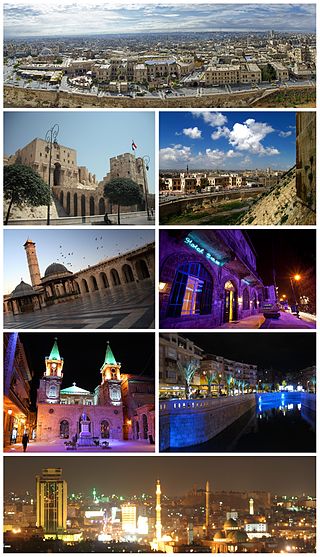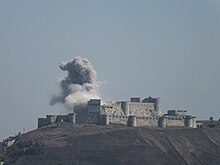
Homs, known in pre-Islamic Syria as Emesa, is a city in western Syria and the capital of the Homs Governorate. It is 501 metres (1,644 ft) above sea level and is located 162 kilometres (101 mi) north of Damascus. Located on the Orontes River, Homs is also the central link between the interior cities and the Mediterranean coast.

Aleppo is a city in Syria, which serves as the capital of the Aleppo Governorate, the most populous governorate of Syria. With an estimated population of 2,098,000 residents as of 2021, it was Syria's largest city until its population was surpassed by Damascus, the largest in Syria's northern governorates and also one of the largest cities in the Levant region.

Hama is a city on the banks of the Orontes River in west-central Syria. It is located 213 km (132 mi) north of Damascus and 46 kilometres (29 mi) north of Homs. It is the provincial capital of the Hama Governorate. With a population of 996,000, Hama is the fourth-largest city in Syria after Damascus, Aleppo and Homs.

A bazaar or souk is a marketplace consisting of multiple small stalls or shops, especially in the Middle East, the Balkans, North Africa and South Asia. However, temporary open markets elsewhere, such as in the West, might also designate themselves as bazaars. The ones in the Middle East were traditionally located in vaulted or covered streets that had doors on each end and served as a city's central marketplace. Street markets are the European and North American equivalents.

Tell Halaf is an archaeological site in the Al Hasakah governorate of northeastern Syria, a few kilometers from the city of Ras al-Ayn near the Syria–Turkey border. The site, which dates to the sixth millennium BCE, was the first to be excavated from a Neolithic culture, later called the Halaf culture, characterized by glazed pottery painted with geometric and animal designs.

Sahyun Castle, also known as the Castle of Saladin, is a medieval castle in northwestern Syria. It is located 7 km east of Al-Haffah town and 30 km east of the city of Latakia, in high mountainous terrain on a ridge between two deep ravines and surrounded by forest, the site has been fortified since at least the mid 10th century. In 975 the Byzantine Emperor John I Tzimiskes captured the site and it remained under Byzantine control until around 1108. Early in the 12th century the Franks assumed control of the site and it was part of the newly formed Crusader state of the Principality of Antioch. The Crusaders undertook an extensive building programme, giving the castle much of its current appearance. In 1188 it fell to the forces of Saladin after a three-day siege. The castle was again besieged in 1287, this time both defender and belligerent were Mamluks. In 2006, the castles of Qal'at Salah El-Din and Krak des Chevaliers were recognised as a World Heritage Site by UNESCO. The site is owned by the Syrian government.

The Citadel of Aleppo is a large medieval fortified palace in the centre of the old city of Aleppo, northern Syria. It is considered to be one of the oldest and largest castles in the world. Usage of the Citadel hill dates back at least to the middle of the 3rd millennium BCE. Occupied by many civilizations over time – including the Greeks, Armenians, Romans, Byzantines, Ayyubids, Mamluks and Ottomans – the majority of the construction as it stands today is thought to originate from the Ayyubid period. An extensive conservation work took place in the 2000s CE by the Aga Khan Trust for Culture, in collaboration with Aleppo Archeological Society. Dominating the city, the Citadel is part of the Ancient City of Aleppo, an UNESCO World Heritage Site since 1986 CE. During the 2010s, the Citadel received significant damage during the lengthy Battle of Aleppo. It was reopened to the public in early 2018 CE with repairs to damaged parts underway, though some of the damage will be purposefully preserved as part of the history of the citadel. The citadel was damaged by the 2023 Turkey–Syria earthquake.

The Great Mosque of Aleppo is the largest and one of the oldest mosques in the city of Aleppo, Syria. It is located in al-Jalloum district of the Ancient City of Aleppo, a World Heritage Site, near the entrance to Al-Madina Souq. The mosque is purportedly home to the remains of Zechariah, the father of John the Baptist, both of whom are revered in Islam and Christianity. It was built in the beginning of the 8th century CE. However, the current building dates back to the 11th through 14th centuries. The minaret in the mosque was built in 1090, and was destroyed during fighting in the Syrian Civil War in April 2013.

The old city of Damascus is the historic city centre of Damascus, Syria. The old city, which is one of the oldest continuously inhabited cities in the world, contains numerous archaeological sites, including some historical churches and mosques. Many cultures have left their mark, especially Hellenistic, Roman, Byzantine and Islamic. In 1979, the historical center of the city, surrounded by walls of Roman era, was declared a World Heritage Site by UNESCO. In June 2013, UNESCO included all Syrian sites on the list of World Heritage in Danger to warn of the risks to which they are exposed because of the Syrian Civil War.

The National Museum of Aleppo is the largest museum in the city of Aleppo, Syria, and was founded in 1931. It is located in the heart of the northern city on Baron Street, adjacent to the famous Baron Hotel and near the Bab al-Faraj Square and Clock Tower. The majority of the museum's exhibitions are devoted to the archaeology of Syria, with most of the finds coming from archaeological sites of the northern part of the country.

The Ancient City of Aleppo is the historic city centre of Aleppo, Syria. Prior to the Syrian Civil War, many districts of the ancient city remained essentially unchanged since they were initially constructed between the 11th and 16th centuries. Being subjected to constant invasions and political instability, the inhabitants of the city were forced to build economically independent cell-like quarters and districts, most of which were delineated along ethnic and religious lines. These urban subdistricts, along with the ancient walled city that they surround, comprise an approximate area of 350 hectares and are home to more than 120,000 residents.
The following is a timeline of the history of the city of Aleppo, Syria.

Al-Hatab Square is one of the oldest squares in the Syrian city of Aleppo. It is located in the old Jdeydeh Quarter, outside the historic walls of the Ancient City of Aleppo. The square suffered catastrophic damage during the Syrian civil war.

Al-Jdayde is a historic predominantly Christian neighbourhood of Aleppo. It is noted for its winding narrow alleys, richly decorated mansions and churches. It was an area of significant cultural and historical interest. Much of Al-Jdayde suffered catastrophic damage during the Syrian Civil War.

Beit Ghazaleh is one of the largest and better-preserved palaces from the Ottoman period in Aleppo. It was named after the Ghazaleh family that owned it for about two centuries. Since 1914, it was used as a public school and restored to host the Memory Museum of the city of Aleppo. Beit Ghazaleh is located in the Al-Jdayde district of Aleppo. The structure has been damaged by warfare and earthquakes.

Deliberate destruction and theft of cultural heritage have been conducted by the Islamic State (IS) since 2014 in Iraq, Syria, and to a lesser extent in Libya. The destruction targets various places of worship under IS control and ancient historical artifacts. In Iraq, between the fall of Mosul in June 2014 and February 2015, IS had plundered and destroyed at least 28 historical religious buildings. Valuable items from some buildings were looted in order to smuggle and sell them to foreigners to finance the running of the Islamic State.

Although Syria has some of the oldest cities in Western Asia, such as Damascus and Aleppo, tourism in Syria has greatly reduced as a result of the Syrian War, that began in 2011 and is ongoing, and its associated refugee crisis. Tourism has been further impacted by the outbreak of COVID-19 starting in March 2020. The international economic sanctions imposed on Syria and the sharp drop in the value of the Syrian pound also adversely impact tourism in Syria. The Ministry of Tourism is the responsible government department.

Beit Achiqbash ; is an old Aleppine courtyard mansion built in the mid 18th Century by Qarah Ali (Karaly), a wealthy Christian merchant.

















